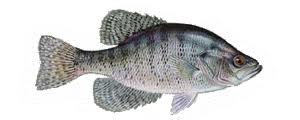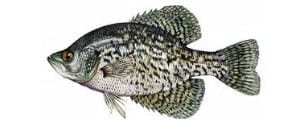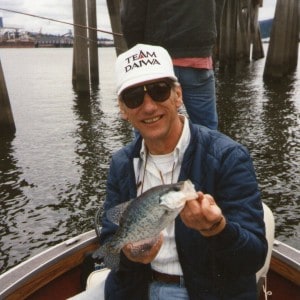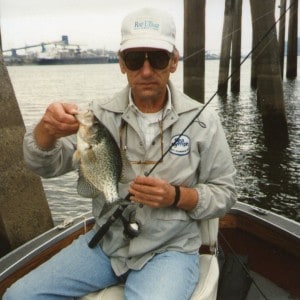By Bud Hartman for Oregon Bass & Panfish Club
 |  |
| White Crappie (Pomoxis nigromaculatus) | Black Crappie (Pomoxis annularis) |
| SHAPE: Body more elongated. | SHAPE: High, arched back. |
| MARKINGS: Spots are arranged in seven to nine (7-9) vertical bars. | MARKINGS: Spots, blotches are scattered irregularly. |
| ANAL SPINES: Six (6). | ANAL SPINES: Six (6). |
| DORSAL SPINES: Six (6). Note – The White Crappie is the only member of the Sunfish family having 6 spines in the dorsal fin and 6 spines in the anal fin. This is the one major feature distinguishing it from the related Black Crappie. | DORSAL SPINES: Seven or eight (7 or 8). |
| WATER PREFERENCE: Prefers silty river and lake areas with more turbidity. | WATER PREFERENCE: Likes quiet, clearer water and seeks vegetated areas. |
| SPAWNING TIME AND DEPTH: Early summer; usually a little deeper at approximately eight (8) feet of water. | SPAWNING TIME AND DEPTH: Spring and early summer; typically three to six (3 to 6) feet of water. |
Crappie Cycles
We sometimes wonder why there are “good” and “bad” years. Crappie tend to be cyclic in populations. Fishing can be good for two to three years and then virtually disappear for a similar time period.
In a good year, crappie produce a large brood (usually 20,000 to 50,000 eggs per female) with good survival rates. This becomes a dominant brood and, in following years, they devour their own young.
This elimination of the young continues until the dominant brood declines in number or until the surviving members can’t remove most of the spawned young produced during this time. The cycle will then repeat.
This “cycling” probably explains why some years most crappie will be of catchable size followed by years when only a very small percentage of the catch is large fish.
 |  |
White (left) and black (right) crappie often inhabit the same waterways, as Bud Hartman shows from these catches in the Willamette River’s Portland Harbor.
Oregon Crappie
Crappie are a popular game fish throughout most of the United States, with both black and white crappies widespread in their ranges.
Near Portland, where the Oregon Bass & Panfish Club is located, both species are common in the Columbia and Willamette river systems.
You might catch more black crappie one day in Multnomah Channel (which forks off the Willamette near Portland) and then move to a lake on Sauvie Island next door and catch mostly white crappie.
Other popular crappie fisheries in Oregon range from Siltcoos, Tahkenitch and Tenmile lakes on the coast to Brownlee, Owyhee and Prineville reservoirs east of the Cascade Mountains.
Bud Hartman compiled this information on behalf of the Oregon Bass & Panfish Club. See OBPC’s profile page.
Bud did a lot of warmwater fishing on the East Coast prior to coming to Oregon (compliments of the US Air Force). He immediately went to work selling fishing tackle at Freeway Sporting Goods, where the original Oregon Bass Club got its start. Bud has been a member of the club since the beginning (some 55 years ago) and is an Honorary Life Member. Bud works as an advisor and fish identification person as a volunteer with the Oregon Department of Fish and Wildlife. He has been an ardent supporter of the right for warmwater fish to exist in Oregon and he will continue to defend their presence in Oregon waters. Bud is also a longtime member of the Warmwater Working Group with ODFW.
Find more good fishing spots at:
Best Warmwater Fishing in Oregon
You might also like: Best Rods, Reels and Tackle for Crappie Fishing.
